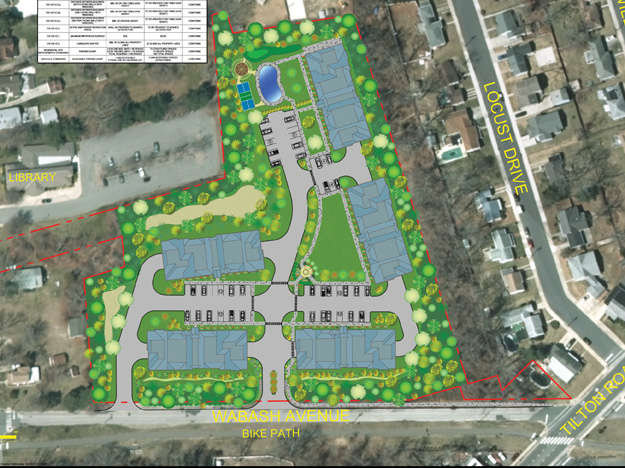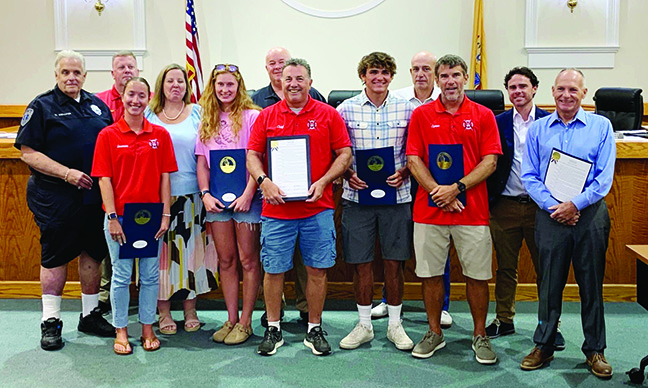77-unit complex is proposed for Wabash Avenue
By CRAIG D. SCHENCK/Sentinel staff
NORTHFIELD — A charitable nonprofit is proposing the construction of a 77-unit age-restricted rental apartment complex along Wabash Avenue between Mill and Tilton roads.
Attorney Stephen Nehmad and Homes for All Inc. Executive Director Glen McDonald appeared virtually before the Northfield Planning Board on Thursday, May 6, for an informal meeting to discuss plans for an “inclusionary, age-restricted housing development.” That means it would be a mix of affordable and market-rate apartments.
Nehmad said the project is important to his client and the city, which needs more affordable homes to meet its requirements under the Council on Affordable Housing.
“In 2018, the city took the old Arthur Henry construction site and put it in the housing plan to allow for the creation of a realistic opportunity for the development of affordable housing,” he said.
Nehmad introduced McDonald as the representative of a 501(c)3 charitable nonprofit housing developer who is ready to get started and eager to come to Northfield.
McDonald said Homes for All has been developing affordable housing for 35 years, with properties in Atlantic, Cape May and Ocean counties, as well as throughout the state.
It has a local office, in the building with The Arc of Atlantic County off Tilton Road, and another in Toms River.
The organization’s mission is to “provide affordable housing and wrap-around services that support working-class families in our region.”
Homes for All currently operates two rental properties in the city, as well as in Egg Harbor Township, Pleasantville and Galloway Township.
McDonald said the organization owns, operates, manages and maintains most of its properties.
“We’re in it for the long haul; this is what we do,” he said.
McDonald said Homes for All is more than just a developer of affordable housing, as it provides rental assistance, emergency home repairs, property management and community outreach as well.
“Last year we served 445 families, built 395 affordable homes, made 40 emergency home repairs, assisted 94 renters with rental assistance and managed 118 properties,” he said. “Changing lives through affordable housing for 35 years — we’re awfully proud about that.”
The plan calls for 38 one-bedroom units and 39 two-bedroom units. According to the documents filed with the board, 15 percent of the homes would contribute to the city’s affordable housing requirement.
Board Chairman Richard Levitt asked if McDonald would be willing to provide more than 15 percent.
McDonald replied that “everything in this community will be affordable, but only a portion will be income-restricted.”
He added that the rent will be at or below market value.
Nehmad said the construction costs require 85 percent market-rate units.

“In order to build a building of this quality, the remainder will be market-rate for active adults 55 and over,” he said.
According to the preliminary plans, there would be five three-story buildings with parking beneath and at least 70 feet between them.
Nehmad called the design “really finely developed, dignified, shingle-style architecture.”
McDonald said each building would have a furnished lobby with mail boxes and access to the elevator.
“This isn’t your ordinary affordable community,” McDonald said. “We don’t believe that affordable means low-budget. We believe people of all income levels should enjoy the same amenities and comforts as everybody.”
The complex would have 58 percent hard surfaces — buildings and pavement — where 65 percent is allowed, as well as two drainage basins.
There would be a total of 146 parking spaces, with 74 on the surface lot. The total would include five van-accessible spots to meet Americans with Disabilities Act requirement.
Ready to move forward
Nehmad said the project is ready to move forward into the hard-engineering stage, a step taken after all of the municipal zoning requirements are met or granted a variance.
At this point, though, changes still could be made.
For instance, according to the plans, a clubhouse, pool, gazebo, pickleball court and putting green — what McDonald called the “amenities package” — would be located in the back left of the 6.5-acre property.
Board member Clem Scharff asked if it could be put in another spot, possibly closer to the parking lot of the Otto Bruyns Public Library, to be farther away from nearby homes.
McDonald said he did not want to double-stack the buildings (put one behind another) to keep the site open, but that limits where each element can go. He also said the proposed design allows for better traffic flow through the complex.
Nehmad noted there would be “significant buffers between the pool and homes.” Plans call for a 25-foot landscaped buffer on all sides.
“This is going to be of very high quality and I think there is a very good market for it,” Nehmad said, noting he expects no problem with the regulatory approvals such as the board’s blessing and a state-issued permit necessary when building in a coastal zone.
“We are not seeking any variances and fully conform with zoning as is,” Nehmad said. Levitt asked if school-age children would be permitted, an important question in a city where school taxes make up 55 percent of the bill.
“We do not to expect much or any of that but it could happen,” McDonald said, noting sometimes older adults raise children. “I don’t expect there to be a high percentage of that. It’s clearly for active adults, which typically means grandchildren visiting.”
Levitt asked if there were any environmental issues with the property, which from the conversation appeared to have been contaminated at one point. It was not listed on the state Department of Health’s list of hazardous waste sites.
Nehmad said there was a No Further Action letter issued by the state Department of Environmental Protection, indicating it had “all been cleaned up.” The timeframe was not mentioned.
Board member Jim Shippen asked if there would be any pedestrian access to the library, which abuts the property. McDonald said he would “love to see some sort of access agreement where our residents could go straight through to the library. That’s how we always envisioned it.”
Board solicitor Joel Fleishman asked if the property would be tax-exempt since the organization is a nonprofit, but McDonald assured him that Homes for All has an obligation to pay real estate taxes.
Levitt loved the idea.
“It is exactly the type of development we envisioned when we changed the zoning from residential to multifamily. It looks beautiful,” he said. “I for one am looking forward to it.”
Asked what he expected the total assessed value of the property to be when fully built, McDonald said “it is too early to provide such a forecast.”
Nehmad said Homes for All is in the process of acquiring the property from the Henry family, noting the deal is contingent on the organization receiving all approvals.
“We are ready to move forward,” he said.
Immediate plans call for 60 to 90 days of hard engineering work.
“We expect to be back in July or August,” Nehmad said.



